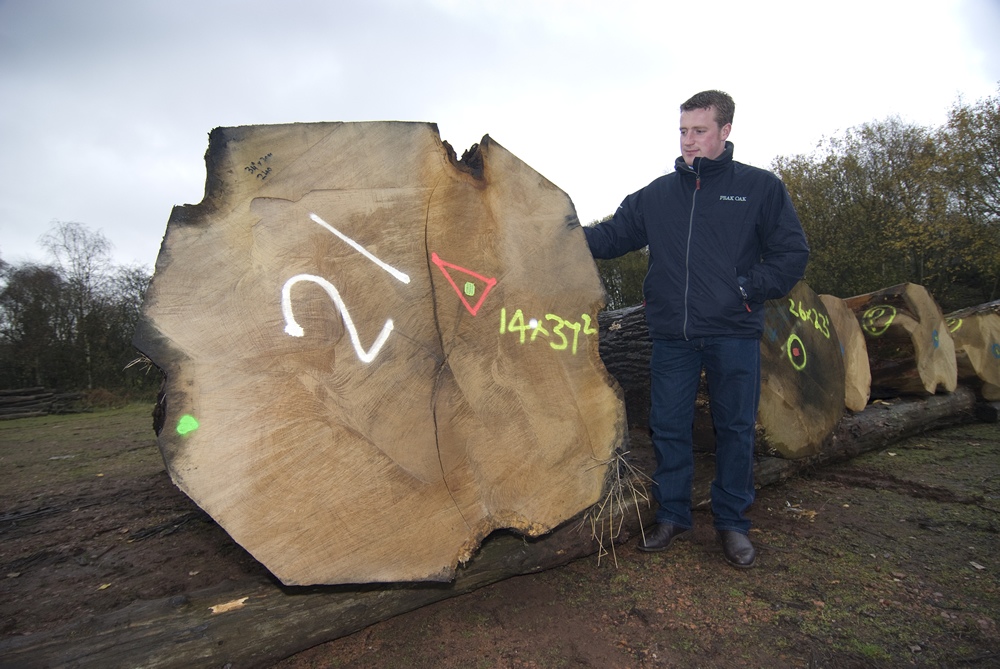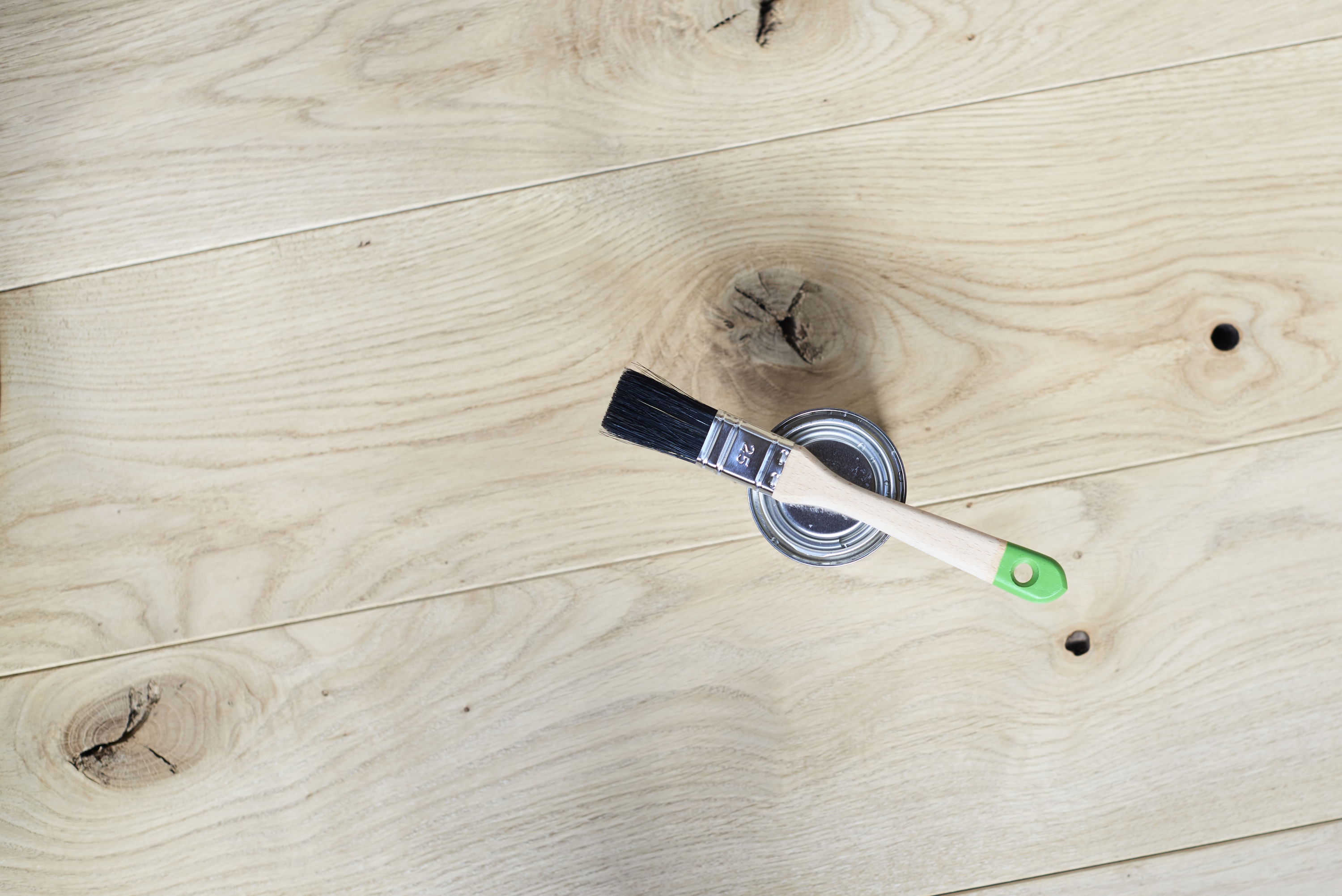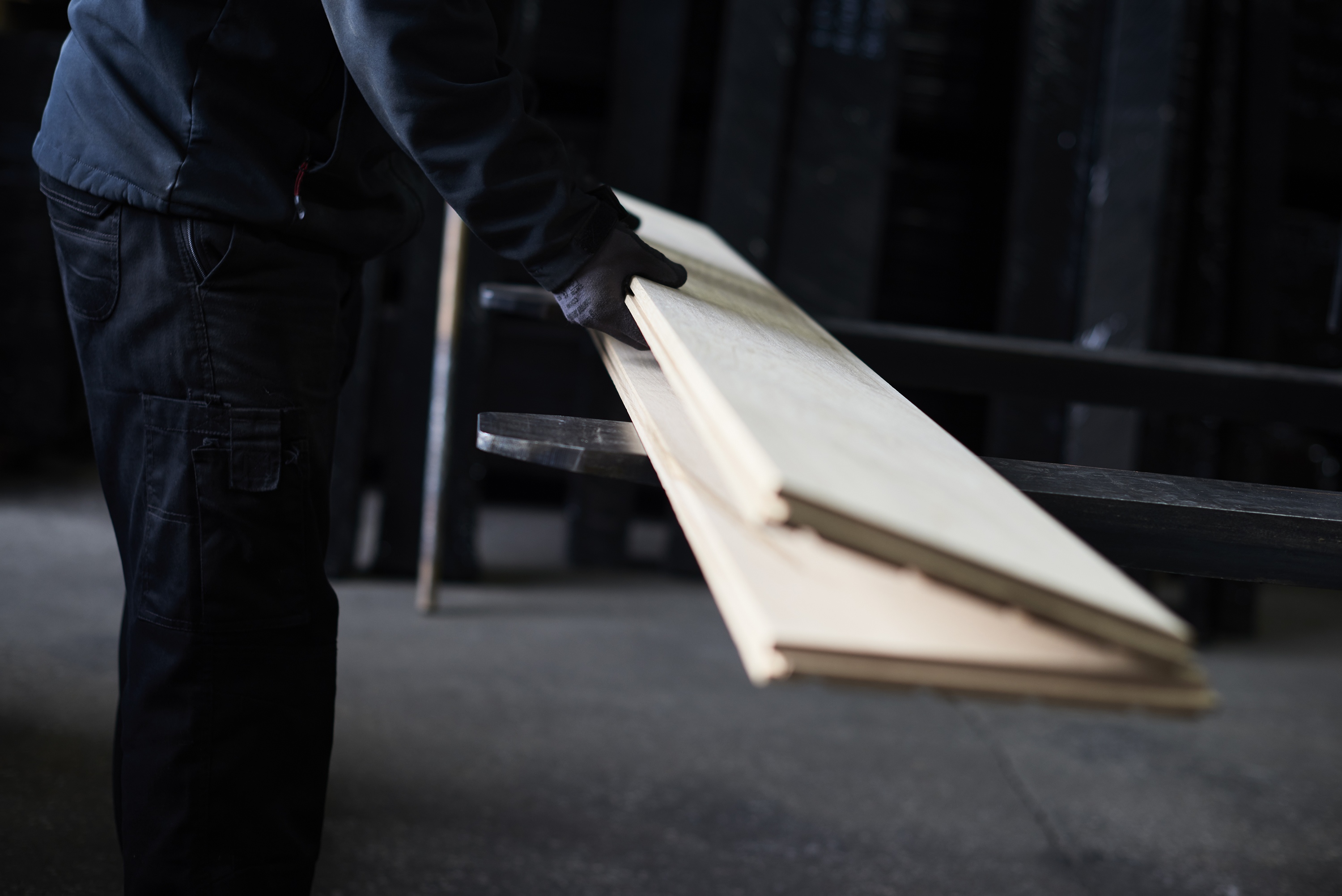Solid oak flooring has been a staple in homes down the ages and was probably used by the very first peoples to settle in Europe.
It's not surprising really, when you think about how durable, easy to work and downright beautiful solid oak can be.
In the days of yore, most of the flooring would have been green oak and installed at the same time as the construction of the dwelling, but over time, air drying and kiln drying became more popular as understanding of the properties of oak grew.
These days, all solid oak flooring is kiln dried to a moisture content of between 8% and 12% to minimise movement in the wood as humidity levels change.
FROM OAK TREE TO OAK FLOOR
Once a suitably sized oak tree has been felled, the main trunk is "cleaned up" by having all of its branches removed to produce what is called a "round".
These oak rounds are then made available to sawmills, timber merchants and flooring producers to select the best for their purposes.

Choosing a good round for flooring is a mixture of skill and good luck, as you can only see the two cut ends and how many branches were removed. Sometimes, it is possible to see traces of the fungus which results in tiger striping or brown oak but in general, the skilled buyer is looking for the density, evenness and spacing of the growth rings.
When a round has been selected it is taken to the sawmill for processing.
Depending on the type of cut required (flat sawn, quarter-sawn, etc.) the round is sliced into 28mm thick layers and put "into stick" to air dry for between 3 months and 2 years - you may have seen this outside timber mills, where a whole sliced round has been left to dry with wooden wedges placed between the layers.
The air dried oak is now placed into a kiln for around 6 weeks to take the moisture content of the wood down to about 10-12% (note that some oak imported into the UK from China, has been dried down to less than 8% whereupon, the moment the oak boards are unwrapped from their airtight packaging, they swell quickly in Britain's damp air and often become mis-shapen).
After the dried wood emerges from the kiln, it is processed into the finished 20mm floor boards you buy for your home - stress grooves are routed, tongues and grooves are added and the boards are planed and sanded to a smooth finish.
THE GRADES OF SOLID OAK FLOORING
Barn Grade
Barn grade, or rustic/pub grade is renowned for its high number of knots, burns, color streaks, shakes, cracks and even holes.
These features give the boards their distinctive character - ideal for use in restoring an old barn or fitting out a rustic pub.
Character Grade
Character is the most commonly found grade of oak flooring, with occasional knots of differing sizes and wide colour variation.
This grade sometimes includes the odd hairline shake too.
Character grade oak flooring is the perfect "Jack of all trades" and looks good in everything from a barn conversion to a modern flat.
Select Grade
Select grade solid oak flooring is essentially a finer version of character grade with fewer knots, shakes and cracks as well as less colour variation.
If you are looking for a "cleaner" look for your floor, select grade offers the best compromise between character grade and prime grade.
Classic Grade
In terms of its knots and shakes, classic grade solid oak flooring is very similar to character grade oak flooring.
The key difference between the pair is that classic grade has the striking figuring of medullary rays.
Medullary rays are caused by plant cells running across the tree at an angle resulting in silky smooth, silver markings across the board.
Prime Grade
If you are looking for utter perfection from your oak flooring, prime grade is as close as you'll come.
Taken form the centre of the oak round, where the growth rings are most tightly packed, prime grade flooring is virtually free from any knots, shakes and burrs, each tree producing only a small quantity of these boards.
Quarter Sawn Oak Flooring
As the name suggests, these boards are created from quarter sawn oak.
The most exclusive (and costly!) way to produce timber planks, quarter sawn oak boards have beautiful figuring and a super tight grain.
With virtually no knots, quarter sawn oak flooring is produced from only a small part of the tree, making it very rare and extremely desirable.
Legere 14mm
If you are looking to install an oak floor which needs to be laid over a plywood sub-floor, while still keeping as much room height as possible, Legere 14mm solid oak flooring is the perfect solution.
A similar grade to character flooring, the 14mm thickness proves just thick enough to make the floor stable, yet thin enough to replace a carpet/underlay combination.
Grange 14mm
Like Legere, this board has been created to cater for those who are after thinner, yet stable solid oak flooring.
The Grange board is based on barn grade oak with all of the same characteristics in a thinner form.
Mansion 14mm
Mansion 14mm solid oak flooring is essentially a character grade with the distinctive tiger striping common to all brown oak and caused by a fungus found in the living oak tree.
An incredibly striking effect when seen in a room setting!
WHERE TO USE SOLID OAK FLOORING
Solid oak flooring is susceptible to movement caused by changing humidity in the atmosphere.
This means it should not be used in areas where the humidity is likely to vary like kitchens, bathrooms and conservatories.
Fitting over underfloor heating is also not advisable, as the constant low heat will continuously dry out the oak causing it to shrink - you'll end up with wide gaps between the boards at best and at worst, may find the boards splitting along their tongues.
Solid oak is perfect for sitting rooms, dining rooms, hallways and bedrooms where the temperature and humidity remain fairly stable.
FITTING SOLID OAK FLOORING
Please note: Before installing any solid oak flooring, leave your newly delivered boards unwrapped in the room where they will be laid for as long as possible.
To ensure better results long term, solid oak flooring should be left for around 2 weeks to acclimatise.
Your Sub-floor
One of the most important factors when it comes to fitting a solid oak floor is the condition and make up of the sub-floor.
The sub floor must be completely dry, and completely flat.
If you are fitting to timber joists or plyboard sub-floors you should also always check that these are completely free from rot and treated for woodworm.
Nailing or Screwing Down Your Floor
Traditionally, oak boards were not tongue and grooved and so were nailed through their top surface at even spacing into floor joists below.
Nowadays, secret nailing or screwing is the preferred method.
This involves using a nail gun or power driver to drive the fixing through the tongue of each board into the subfloor or joist.
The tongues are hidden by the groove of the next board and so the fixings are hidden, giving a fixing free finish to the laid floor.
Glueing Down Your Floor
An alternative method for fixing your floor is to use an adhesive to stick the boards to a sub-floor.
It is vital that you choose a glue specifically for this job - it must be extremely strong and yet flexible enough to allow for some movement in the wood.
If you use a rigid glue, you are likely to find your oak floor splitting, buckling or even worse, causing major structural damage to your home!
We do not recommend glueing solid oak flooring boards which are wider than 120mm in width.
FINISHING YOUR OAK FLOOR
The finish of your oak floor is a question of personal taste - whether an oak board is finished or unfinished it will still retain its hard-wearing, durable state.

Unfinished Flooring
Unfinished flooring gives you the greatest scope for achieving the look you are after.
You can apply stains, wood dyes and any number of waxes or oils and many of these can be reversed by sanding if you change your mind!
Oiled
Oiled floor boards have a natural appearance caused by the oil soaking into the floor and leaving the grain showing through.
You will need to oil a floor annually to keep it looking good.
Pre-lacquered
Any board that comes pre-lacquered will have been factory finished with approximately 5 coats of lacquer.
This gives the boards a smooth and hard wearing finish which requires no on-going maintenance, but which is permanent.
MAINTAINING YOUR OAK FLOOR
Most solid oak floors are very easy to maintain - a simple sweep or vacuum once in a while will keep dust and grit off the surface and a wipe with a damp mop will keep them looking like new.
Oak flooring will scratch, so if you have furniture with sharp legs, felt pads may be a worthwhile investment.
SOLID OAK FLOORING NOW
These days, demand for solid oak flooring, especially in North America, has grown to such an extent, that quality has started to suffer.
Many oak flooring retailers supply pre-wrapped flooring packs, containing short lengths, where you have no idea what you are getting until you get the pack delivered and open it up.

Only a handful of suppliers now deal in the highest quality European oak in hand selected, long lengths and wide boards - needless to say, we're one of them!
Call us on 01538 304584 to talk to us about your flooring project.

